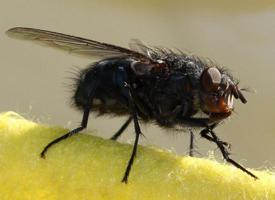
Poids et mesures
| Longueur | de 6 à 12 mm |
|---|---|
| Vitesse | 8 km/h |
Statut de conservation
| Intrépide |
Description de l'animal
The housefly, scientifically known as Musca domestica, is one of the most common and widely distributed insects across the globe. Belonging to the order Diptera, this species is a true fly and has been living in close association with humans for millennia, thriving in environments altered or created by human activities. As such, the housefly has become a ubiquitous presence in human settlements, from the densest urban areas to rural farms.Adult houseflies are typically about 6 to 7 millimeters in length, with a wingspan of about 13 to 15 millimeters. They are characterized by their grayish bodies, with four dark, longitudinal stripes on the thorax. Their compound eyes are large and multifaceted, giving them a wide field of vision that is crucial for evading predators. The females are generally larger than the males and can be distinguished by the space between their eyes, which is wider than that in males.
The life cycle of the housefly is fascinating, progressing through a complete metamorphosis that includes the stages of egg, larva (also known as maggot), pupa, and adult. Females lay their eggs in moist, decaying organic matter such as compost, manure, or garbage, providing an ideal environment for the larvae to thrive. These larvae are whitish in color and can consume vast amounts of food, enabling them to grow rapidly. After several molts, they enter the pupal stage, during which they transform into adults. This cycle can be completed in as little as a week under optimal conditions, allowing housefly populations to increase rapidly.
Houseflies are notorious for their role in the spread of diseases. They are attracted to a variety of food sources, including human food, animal feed, and various forms of waste. As they move from one source to another, they can pick up and transport pathogens on their bodies and through their feces, potentially contaminating food and surfaces that come into contact with humans. Among the diseases that can be spread by houseflies are typhoid fever, cholera, dysentery, and a variety of food poisoning bacteria.
Despite their small size, houseflies possess remarkable abilities. They are excellent fliers, capable of quick maneuvers and flying up to 5 miles from their birthplace, though they typically stay within a much smaller range if food sources are abundant. Their compound eyes allow them to see in nearly all directions at once, helping them detect and evade threats. Additionally, houseflies taste with their feet, which are equipped with chemoreceptors that allow them to identify suitable food and laying sites.
Control of housefly populations is a significant concern, particularly in areas where they pose a risk to public health. Methods of control include sanitation practices to eliminate breeding sites, the use of insecticides, and the introduction of natural predators or parasitoids. In recent years, there has also been interest in the potential of genetic modification to control or eradicate housefly populations, although such approaches are still in the early stages of development.
In summary, the housefly, Musca domestica, is a fascinating creature that plays a complex role in human environments. While often considered a pest due to its association with disease transmission, its ubiquity and resilience make it an interesting subject of study within the field of entomology.
Nouvelles photos d'animaux
Top 10 des animaux
- Dolphin gull (Leucophaeus scoresbii)
- Japanese macaque (Macaca fuscata)
- Stone loach (Barbatula barbatula)
- Greek tortoise (Testudo graeca)
- Russian tortoise (Testudo horsfieldii)
- Galápagos tortoise (Geochelone nigra complex)
- Diana monkey (Cercopithecus diana)
- Moustached guenon (Cercopithecus cephus)
- Common flying dragon (Draco volans)
- Galápagos penguin (Spheniscus mendiculus)